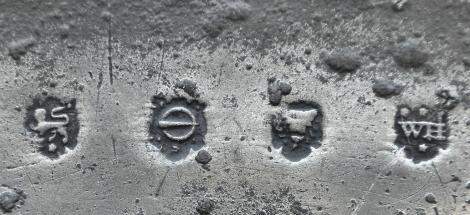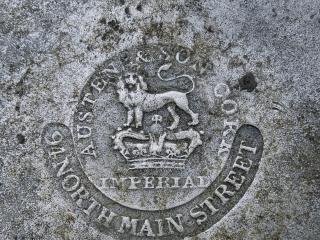Non British/Irish Pewter

There is no comprehensive online or printed guide to pewter marks from across the whole world. Indeed, in many countries or regions, no one has yet researched old pewter marks, which means identifying them is very difficult. However the United States and a number of European countries have been well researched and there are books that will help you identify marks from those areas.
American pewterers
American pewterers used touch marks, quality marks and, occasionally, hallmarks that are broadly similar to those used by British pewterers. To identify them, try:
Pewter In America; Its makers and their marks by Ledlie I Laughlin, American Legacy Press 1981 (three volumes in one), ISBN 0 517 35063 7
Irish Pewter Marks
The actual makers marks take two forms, touch marks which were probably in the days of Guild domination, registered with the Guild Officers and secondary marks, which resemble in many ways silver hallmarks and are called either secondary marks or commonly hallmarks, although they do not have the same connotation as silver marks but are intended to superficially resemble them. No touch or secondary marks can be securely identified, at present, as being Irish before the second half of the 17th century although no doubt such marks were in use. The hall marks are well recorded however the touch itself only survives in incomplete versions. It may include an Irish harp and the name of the pewterer. These marks can be dated to the last quarter of the 17th century and may, if the hallmarks are meant to be more than just traditional symbols, have some political significance. The lily is placed between the harp and the rose suggesting a date around 1688-91. This is however no more than speculation.
The use of the Irish harp, in touches and secondary marks, continued in Ireland throughout the 18th century and into the early 19th century although on a reducing basis. It sometimes is beautifully drawn and consequently makes an impressive touch. Unfortunately the harp was also used in England. Certain Bristol pewterers included the harp in their touch or hallmarks for reasons presumably of trade with Ireland. Some eight London pewterers also used the harp in their touches and in particular John French, Edward Holman, John Quick and Samuel Withers or Witters. All eight of these struck their touches between 1670 and 1700 after which time the harp seems to have fallen out of favour in London. It could be of course that these individuals were exporting on some scale to Ireland, as other London pewterers were doing to Port Royal in Jamaica in the same period. It could also of course mean that some of the individuals were Irish or had Irish connections and that they intended to go to Ireland to work as the three London pewterers mentioned above had in an earlier decade (mentioned 1656/7).
In the 18th century the use of secondary or hallmarks by Irish pewterers became common and although the devices chosen are not dissimilar to those used by contemporary English makers some do seem to have been particularly favoured by Irish pewterers in addition to the harp. In this category one can place deer, birds, a spiky crown and surprisingly thistles. Also in this context it is important to note that hallmarks were used by some Irish pewterers to mark items where elsewhere one would normally expect to find a touch mark. This seems to have been a particular feature of the work of John Heaney of Dublin and certain associated craftsmen. Finding a row of bold hallmarks in a beer pot is not usual.
Another feature of the marks of the 18th and early 19th century Dublin pewterers was use of a touch which gives the address of the craftsmen. From such marks we learn that pewterers and braziers were located in Back Lane, Capel Street, Cook Street and Ormond Quay. The final example of this type of touch is perhaps that used by the successors of Joseph Austen. This unusual large bold touch with its Crown and 94, North Main Street address is striking and perhaps has contributed something to the popularity of haystack measures many of which are marked with the touch.
Before concluding this piece it is perhaps necessary to deal briefly with the question where you can find Irish Pewter today. The collector will see some pewter offered for sale in antique shops in Ireland, although most of it will except for plates, be of comparatively recent date and some items will bear a suprisingly heavy level of oxidisation. The damp conditions, particularly in the West can lead to the early and rapid development of a dark hard oxide on the surface of the metal. Some of what is offered will of course not be Irish, while other pieces may be reproduction or fakes. Both the National Museum in Dublin and the Ulster Museum have collection of pewter of some considerable quality although to the best of my knowledge little of it is on permanent display. In some other Museums odd pieces of pewter can be seen. Probably in terms of museums the interested individual will have to go to Great Britain or America to see a permanent display of Irish Pewter and then only as part of a more general display. Likewise if you wish to buy good quality pieces you are likely to have more success in Britain or in the United States. Unfortunately much Irish Pewter seems to have emigrated as have countless generations of Irish people.
Courtesy of D W Hall from his book IRISH PEWTER
Below you will find a pdf on Irish Pewter Marks
European pewterers
As a general rule, in mainland Europe the marking of pewter was more tightly controlled by the local guilds than in Britain. The style of mark often identifies the town, and indeed often includes the emblem or arms of the town. Dates in such marks have nothing to do with the pewterer. They simply indicate the date of the relevant guild regulations, which in some instances may have been introduced 200 years earlier.
The following booklet does not itself contain marks but is a comprehensive list of all the principal source books for European marks, with analyses and comments. It can be purchased from the Society.
Books on European Pewter Marks by Jan Gadd, The Pewter Society 1999, ISBN 0 9508658 8 5
